Articles Menu
Apr. 22, 2021
The 724-page federal budget made vital spending commitments to extend supports to Canadians as the pandemic shock waves continue. It also made critical social safety net improvements, most notably universal child care and increases in old age security and supports for eldercare.
But where is the road map to reduce Canada’s carbon emissions? If we are to have a serious chance of meeting net-zero targets by 2050, Canada must phase out fossil fuel production and use, eliminate fossil fuel subsidies and financing, and end all carbon-emitting activity. This is especially true given that Canada provides more public finance to the fossil fuel sector per capita than any other G20 country.
In a paper for the Cascade Institute, University of Waterloo academics Angela Carter and Truzar Dordi have calculated, based on government projections, that fossil fuel production in Canada is scheduled to rise until 2039 and remain above current levels in 2050. They conclude that Canada, with 0.5 per cent of the world’s population, would exhaust 16 per cent of the world’s remaining carbon budget to maintain emissions below 1.5C.
The 2021 budget provides major funding of $17.6 billion for the transition to a green economy, including $319 million over the next seven years for research and development for potentially problematic carbon capture and storage.
It earmarks $1 billion over five years to attract private capital to clean tech industries, and a $5 billion green bond issue in this fiscal year to fund infrastructure, clean tech and conservation projects. This is in addition to $3.4 billion — the bulk of it for departmental funding — over five years for land waterways and ocean conservation. It also allocates $4.4 billion in interest-free loans to landlords and homeowners for home retrofits.

But there are no mandated requirements to ensure those getting the funding meet the government’s zero emissions goal — simply lots of carrots, but no sticks. All of this is consistent with what the big business lobby was demanding. The words “climate,” climate change" and “climate crisis,” in fact, did not appear once in the finance minister’s speech.
Canada’s climate emissions have risen 26 per cent since the 1997 Kyoto Protocol. By comparison, American emissions have remained stable and the European Union’s emissions have declined 25 per cent from the Kyoto accord’s 1990 baseline. Even during the past five years, while the Liberals have been in power, Canada’s emissions have continued to creep up.
The government did announce a new target in the budget. It aims to reduce emissions to 36 per cent below 2005 levels by 2030. Reportedly under pressure from the Americans, Prime Minister Justin Trudeau announced a further reduction to between 40 and 45 per cent at the U.S.-sponsored Earth Day climate summit.
Yet this still amounts to only a 20-22 per cent reduction since the 1990 Kyoto baseline. The EU, meantime, has strengthened its pledge to reduce emissions 55 per cent below its 1990 levels. Globally, the target needs to be about 25 per cent below 1990 levels for a chance of maintaining temperatures at 1.5C. Given Canada’s record of broken promises, skepticism about its ability to meet these commitments is understandable.
There was also scant action in the budget on tackling income disparities, even though the link between carbon emissions and inequality is striking. The world’s richest families have a disproportionate impact on climate. In 2015, the top one per cent accounted for 15 per cent of global emissions, almost half of them from North America. The top 10 per cent accounted for more than half of global emissions, almost a third from North America.

In Canada, the richest 0.1 per cent emitted 136 tonnes of CO2 per capita in 2015. The bottom 50 per cent of Canadians in terms of income, by comparison, emitted only seven tonnes of CO2 that year.
Last September’s speech from the throne promised to “identify additional ways to tax extreme wealth inequality.”
But there was no wealth tax on the super-rich in the budget, no increase in the top income tax bracket or the capital gains tax, no surtax on billionaires disproportionately profiting from the pandemic despite the fact that, a year into the crisis, Canadian billionaire wealth was up by $78 billion.
Read more: The throne speech must blaze a bold new path — including imposing a wealth tax
The top one per cent of Canada’s income earners hold 26 per cent of Canadian wealth. The top 10 per cent hold 56.4 per cent of family wealth, while the bottom 50 per cent of Canadians hold a negligible 1.2 per cent of total family wealth. The budget announced a few boutique taxes for the very wealthy and limits on interest deductibility. That’s about it.
The aforementioned social spending commitments could greatly improve the living conditions for low- to middle-income households and vulnerable populations, but they’ll barely make a dent in bringing down overall income and wealth inequality to where it stood in the early 1980s. Between 1982 and 2018, average incomes for the top one per cent doubled in Canada, with most of those income gains going to the top 0.01 per cent. Average real income for the bottom half of Canada’s income earners declined during the same period.
Canadian financial institutions, rife with one of the world’s most “climate-conflicted bank directors,” continue to lend massive amounts of money to the fossil fuel sector. The world’s biggest 60 banks, including four of the big five Canadian banks, have provided US$3.8 trillion of financing for fossil fuel companies since the Paris climate accord came into effect in 2016, according to the Banking on Climate Chaos 2021 report.

Yet there’s nothing in the budget to indicate that the Bank of Canada and the Office of the Superintendent of Financial Institutions will clamp down on lending to the fossil fuel industry.
Global corporate tax rates have plummeted over the past four decades, including in Canada. The average worldwide statutory corporate tax rate fell from 40 per cent in 1980 to 24 per cent in 2020.
In the United States, the Joe Biden administration has unveiled a plan to raise American corporate tax rates to 28 per cent from 21 per cent.
But there was no increase in Canadian corporate rates in this budget. Nor does the budget mandate carbon reduction targets for corporations that receive government funding, continuing to let private sector’s environmental, social and governance [ESG] investment fund initiatives take the lead, even though they invariably favour profit over climate.
Read more: Sustainability rankings don't always identify sustainable companies
The snail’s pace of action in this year’s federal budget is out of step with the urgency of the climate and income inequality crises.
It’s done nothing to threaten the plutocracy’s hold on power and privilege. Most disconcerting, Canada remains an outlier in the global effort to prevent the slide towards the climate abyss.
Adjunct professor, Faculty of Environmental Studies, York University, Canada